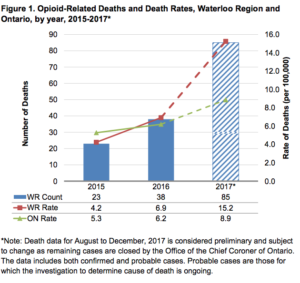by Diego Duran
Opioid-related deaths have been on the rise in the Waterloo region. Rising almost 270% from 2015-2017, this year is on track to becoming one of the highest years to date. With such increase, the region has begun to act and revamp their approach to this on-going crisis.
The effects of the opioid crisis have been on the rise in the Waterloo region with a reported 23 opioid related deaths in 2015, 38 in 2016 and 85 in 2017. The regions Paramedic Services have also seen a 304% increase in the number of opioid related overdose calls, with calls concentrated in Central Kitchener, Central-South Kitchener, and South Cambridge. With such a rise, the Waterloo Region’s opioid related death rate has surpassed the average for the province of Ontario.
The Waterloo Region Integrated Drug Strategy Special Committee in conjunction with Public health and stakeholders is leading the new Opioid response plan, with the committee working hard to address issues such as substance abuse since 2012.
The current response plan is designed on a four-pillar approach with a “fifth pillar” that incorporates all the previous ideas into an integrated plan. The four pillars are categorized into Prevention, Harm Reduction, Recovery and Rehabilitation and Enforcement and Justice with an overall goal of preventing, reducing or eliminating negative opioid use. The new response plan focuses on revising and adding new strategies to the current one. The following will describe the new proposed strategies in each of the corresponding pillars.
In the Prevention pillar, the committee proposed a Youth engagement strategy similar to the Youth in Iceland approach. The youth engagement strategy uses a community and evidence-based approach to bring youth and families in the region together- removing participation barriers and creating more engagement opportunities. Another proposed strategy was to further expand caregiver and youth substance use education and awareness strategies, focusing on empowerment among all age groups. This strategy aims to empower children, youth, and young adults to make healthy decisions not just in the midst of peer pressure but also in the rapidly changing culture of substance use. This strategy involves many different mediums to convey the message of empowerment through better educating parents, embedding these issues in the elementary and high school curriculum and delivering key messages to colleges, universities, arenas, bars, etc.
In the Harm Reduction pillar, the committee proposed establishing a designed location where people may use substances under the care of trained staff. These locations would be located in areas identified as being in higher need. Here, services would be easily accessible in attempt to lower the overdose death rate.
In the Recovery and Rehabilitation pillar, the committee proposed to expand the already implemented Rapid Access Addiction Medicine Clinics. These clinics are available to anyone seeking help in combating substance use addictions. The expansion of these clinics in the region are to extend operational hours, create more clinics around the region, and to further integrate these services in the overall range of care. Another proposed strategy is to introduce opioid replacement therapy in residential treatment. This strategy will allow for treatments that replace illegal off-label opioids with longer lasting medications under medical supervision, cutting down the effects of withdrawal.
In the Enforcement and Justice pillar, the committee proposed on building the community to implement the LEAD strategy – designed around the model already established in the state of Seattle. LEAD stands for Law Enforcement Assisted Diversion, however there is a lack of resources to implement this strategy into the community.
Finally, in the Integration pillar, the committee has proposed five new strategies with the first being a seamless care pathway. This strategy focuses on a seamless pathway of care from entry to care after treatment and even including incarceration. The goal is to make the healthcare pathway as easy as possible in each pillar. This strategy emphasizes on the needs of the community.
The second strategy takes on an educational approach to reduce the stigma accompanied with substance abuse. A client’s journey to recovery is heavily dependent on their first interactions with their primary healthcare provider. In order to keep sparking a client’s motivation to recovery, this strategy focuses on lowering the stigma among healthcare providers and better equip them with the proper tools needed to handle a person suffering from substance abuse.
The third strategy focuses on a community anti-stigma communication. Like the Bell Let’s Talk campaign, this strategy focuses on opening up the community to talk about these issues in an inclusive de-stigmatizing view.
The fourth strategy is a Social and Corporate Impact Investment strategy. Here the need of funding by the community or corporations can aid to solve issues such as the opioid response.
The fifth and final strategy is for better pain management through knowledge and services. This strategy emphasizes the need to find better approaches to deal with pain, across all pillars. Education is need by healthcare providers to better understand alternative options to deal with pain and addiction.
As of February 2018, the committee has been working diligently to create this new response plan. The plan was completed and integrated into the region in June of 2018, but throughout the summer months the committee has reviewed the new and existing strategies to prioritize a small number of strategies to focus on in the coming year.
This new response plan serves to be a living document that can be changed in response to the community’s needs. Monthly meetings will be held by the committee to report and review any progress of the plan. For further details on the response plan please visit their website.































